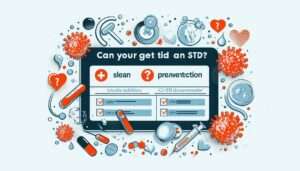Can You Get an STD if Both Partners Are "Clean"? Understanding STD Transmission and Prevention
When it comes to sexual health, one of the most common questions people ask is whether it’s possible to contract a sexually transmitted disease (STD) if both partners are “clean” or STD-free. The short answer is yes, it’s possible – but let’s dive deeper into why this can happen and how you can protect yourself and your partner.

Table of Contents
ToggleUnderstanding What "Clean" Really Means
First, let’s address the term “clean.” When discussing sexual health, it’s better to use more accurate terms like “STD-free” or “tested negative for STDs.” Using the word “clean” can perpetuate stigma and isn’t medically accurate. With that in mind, let’s explore why even partners who believe they’re STD-free might still be at risk.
Pubic Lice (Crabs): Symptoms, Diagnosis and Treatment
The Limitations of STD Testing
While STD tests are crucial for maintaining sexual health, they’re not perfect. Here’s why:
- Testing windows: Many STDs have a “window period” between infection and when they can be detected by tests. For example, HIV can take up to 3 months to show up on some tests.
- Not all STDs are routinely tested: Standard STD panels don’t include every possible infection. Some, like herpes or HPV, may not be tested unless specifically requested or symptoms are present.
- False negatives: No test is 100% accurate, and false negatives can occur, especially if testing is done too soon after potential exposure.
- Asymptomatic infections: Many STDs can be present without causing noticeable symptoms, leading people to believe they’re STD-free when they’re not.
How STDs Can Be Transmitted Between "Clean" Partners?
Even if both partners genuinely believe they’re STD-free, transmission can still occur. Here’s how:
Reactivation of Dormant Infections
Some STDs, like herpes and HPV, can lie dormant in the body for long periods. A person might test negative or have no symptoms for years, only to have the infection become active later.
Giardiasis: Understanding, Preventing and Treating the “Beaver Fever”
New Infections During the Relationship
If either partner has sexual contact with someone else during the relationship, they could contract an STD and pass it to their primary partner.
Non-Sexual Transmission
Some infections classified as STDs can be transmitted through non-sexual means. For example, hepatitis B can be spread through sharing personal items like toothbrushes or razors.
Misunderstanding of Previous Test Results
Partners might misinterpret or misremember previous test results, leading to a false sense of security.

The Importance of Open Communication
To minimize the risk of STD transmission, open and honest communication between partners is crucial. This includes:
- Discussing sexual history and previous STD testing
- Being clear about the definition of monogamy or exclusivity in your relationship
- Agreeing on safer sex practices and consistently using them
- Regularly getting tested together and sharing results
Comprehensive STD Prevention Strategies
While no method is 100% foolproof, these strategies can significantly reduce your risk of contracting an STD:
Regular Testing
Get tested for STDs at least once a year if you’re sexually active, or more frequently if you have multiple partners or engage in higher-risk behaviors.
Giardiasis: Understanding, Preventing and Treating the “Beaver Fever”
Consistent Use of Barrier Methods
Use condoms, dental dams, or other barrier methods consistently and correctly during sexual activity. Remember that these methods don’t protect against all STDs, but they significantly reduce the risk for many.
Vaccination
Get vaccinated against preventable STDs like HPV and hepatitis B. The CDC recommends HPV vaccination for all people through age 26, and in some cases, for adults aged 27-45.
Mutual Monogamy
If you and your partner agree to be sexually exclusive, stick to that agreement. Remember that monogamy only protects against STDs if both partners are truly STD-free and remain exclusive.
Pre-Exposure Prophylaxis (PrEP)
For those at high risk of HIV, consider taking PrEP, a daily medication that can significantly reduce the risk of contracting HIV.
What to Do If You Suspect an STD?
If you or your partner develop any unusual symptoms or suspect an STD transmission despite believing you were both “clean”:
Sexually Transmitted Infections (STIs): A Comprehensive Guide to Understanding, Prevention and Treatment
- Stop sexual activity to prevent further transmission
- Get tested as soon as possible
- Be honest with your partner about your concerns
- Seek medical treatment if necessary
- Use this as an opportunity to discuss and improve your sexual health practices
The Role of Healthcare Providers
Don’t hesitate to consult healthcare providers about your sexual health concerns. They can:
- Provide accurate, up-to-date information about STDs
- Recommend appropriate testing based on your individual risk factors
- Prescribe treatments or preventive medications when necessary
- Offer counseling on safer sex practices
Remember, healthcare providers are there to help, not judge. Be honest with them about your sexual practices to receive the most appropriate care.
Do Condoms Expire? Everything You Need to Know About Condom Safety and Shelf Life
What to Do If You Test Positive
If you test positive for an STI, don’t panic. Remember:
Dental Dams: The Ultimate Guide to Safer Oral Sex
- Many STIs are curable, and all are treatable.
- Follow your healthcare provider’s treatment plan exactly.
- Inform your recent sexual partners so they can get tested and treated if necessary.
- Abstain from sexual activity until your treatment is complete and your healthcare provider gives you the all-clear.
Conclusion:
While it’s possible to contract an STD even if both partners believe they’re “clean,” understanding the limitations of testing and practicing comprehensive prevention strategies can significantly reduce your risk. Remember, sexual health is an ongoing process that requires open communication, regular testing, and consistent safer sex practices. By staying informed and proactive, you and your partner can enjoy a healthy sex life with peace of mind.
Reference to External Sources:
- Centers for Disease Control and Prevention (CDC) – STD Risk and Oral Sex: https://www.cdc.gov/std/healthcomm/stdfact-stdriskandoralsex.htm
- World Health Organization (WHO) – Sexually Transmitted Infections (STIs):
- National Institutes of Health (NIH) – STDs:
- American Sexual Health Association – STI Testing:
- Planned Parenthood – STD Testing, Treatment, and Vaccines:


